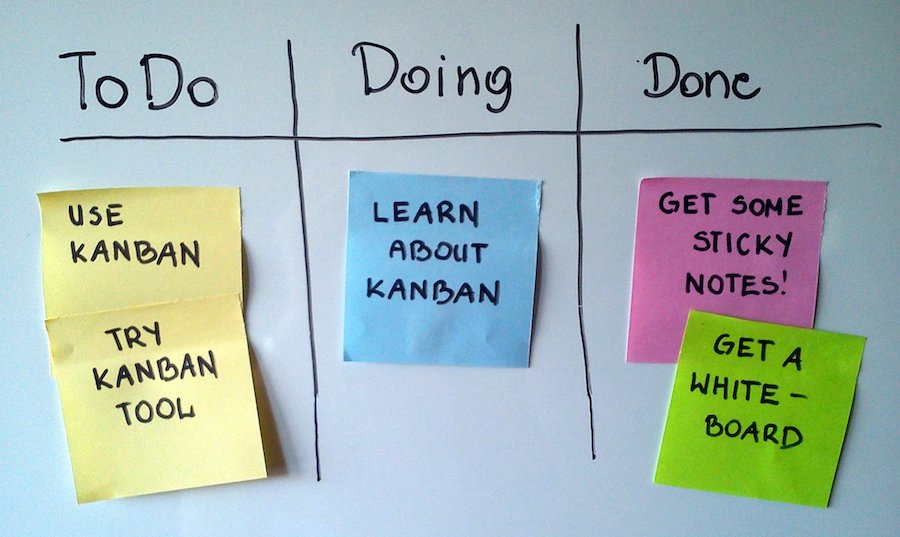Let’s start with the obvious: the best to-do list format produces results.
That doesn’t automatically mean it feels great, or that everyone likes it. It also doesn’t mean everyone hates it.
According to Janet Choi and Walter Chen, authors of The Busy Person’s Guide to the Done List.
· 41% of to-do list items are never completed
· 50% of to-do list items are finished within a day, many within one hour
There are a few of reasons behind this, but there’s one problem that really affects performance.
Format.
The right format makes it easier to get things done. Ideally, your format of choice works with your organization’s culture, making it easier for individuals and teams get results.
Here’s a few new formats you can use to improve your daily to-do list.
To-Do List Format #1: Kanban Board

Kanban boards use the Kanban method to visualize work. Used originally for software development teams, the Kanban method focuses your attention on the to-dos you have to do right now. It’s been applied successfully to a wide variety of business functions, but you don’t have to have a fancy app or program to do it. You can create your own Kanban board with a few sticky notes and an actual board.
It’s beneficial because it gives you an overview of the work that needs to be done at a glance. It’s also helpful because it enables individuals to focus on one task or to-do item at a time.
To-Do List Format #2: The Pomodoro Technique
The Pomodoro technique is a simple yet effective way to optimize your to-do list. Here’s how it works.
1. Choose a task. Your to-do can be large, small, current, outdated. As long as it deserves your undivided attention it’s perfect.
2. Set a timer for 25 minutes. Commit to spending just 25 minutes on a particular task. Work on that task until your timer rings.
3. When your timer rings, make a checkmark. Make note of the fact you’ve spent 25 uninterrupted minutes on your task.
4. Take a short break. Do something relaxing, take a quick walk, play a game, watch a video – anything that’s not work related. Repeat steps 1 – 4.
5. Take a longer break. Once you’ve completed 4 sessions (25 minutes each) take a longer break – 30 minutes or so. Just enough for you to feel refreshed but not long enough for you to completely lose your rhythm.
It works because…
· Pomodoro trains you to eliminate interruptions
· You’ll get better at estimating your time and effort
· You’ll get better at estimating any task
· You’ll work more efficiently, to maximize your 25 minutes
· It’s easy to spot areas in need of improvement
This technique eliminates burnout, minimizes distractions and maximizes your time – improving work/life balance in the process.
To-Do List Format #3: Don’t Break the Chain
Prefer to rely on the calendar in your project management tool? If so, Don’t Break the Chain is for you.
This to-do list format was popularized by Jerry Seinfeld and it works like this.
1. Pick a goal or to-do, something you want to start doing regularly, whether it’s personal or professional. Choose no more than three.
2. Set a daily minimum for each goal e.g. I’ll read a chapter in one sales or marketing related book every day. I’ll create 10 new business/product ideas everyday.
3. Create rules and set boundaries. What happens if you’re on vacation? What if you get sick or have to deal with a family emergency? Set the boundaries and rules for forgivable offenses. You’re in charge.
4. Print out a monthly or yearly calendar Make a big X or checkmark to mark the days where you met your goal successfully. Put your calendar in a place where you’ll see them regularly. Enjoy the satisfaction that comes with a job well done.
5. Complete your goal without fail. When you’re successful you mark that day on your calendar. You want to keep that chain of success going for as long as possible.
This to-do-ish methodology works for just about anything whether its personal or professional.
Coding, writing, marketing, cleaning – you name it.
To-Do List Format #4: The 1-3-5 List
This to-do list is simple, straightforward and effective. Choose 1 big to-do, 3 medium to-dos and 5 small to-dos to focus on.
Prioritization is an inherent part of the 135 to-do list.
You tackle the biggest to-do first, working your way to the small to-dos at the end of your short list. It’s effective because it creates positive forward momentum.
Smash through your biggest and most daunting to-do first, and your day gets easier from there. It’s a rewarding approach to to-do lists and it minimizes your stress and fear levels naturally.
Here’s the best part.
It’s focused on roughly six to-do items. We can only handle seven items at a time before we’re completely overwhelmed.
Psychologically and emotionally, the 135 to-do list feels like you’re sledding downhill. It’s a wonderful way to work.
If you find it tough to prioritize your workload or you’re having a hard time deciding how to start your day this could be a good fit.
When your to-do list works, it feels fantastic
It’s incredibly satisfying to check off a completed to-do. You feel like a productivity machine.
But that’s not how it usually works.
For many of us it’s actually the opposite. Our to-do lists aren’t working. Instead of focusing your attention on the tasks that matter most, they increase your stress.
The traditional to-do list isn’t working.
Traditional to-do lists make work miserable, discouraging and stressful. It doesn’t have to be that way. You don’t have to struggle with a to-do list that doesn’t work for you.
What if to-dos improved your odds of success?
What if your to-do list enabled you to get the kind of results you’re looking for without the fear, stress and discouragement? It’s possible if you find the right format.
It all depends on you. Find the to-do list that works with your organization and your personality and you’ll find the productivity aid you need to maximize your results, no failure required.




